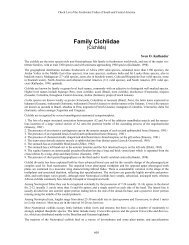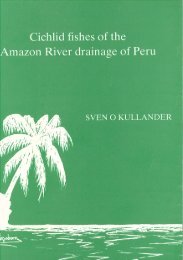Open Access PDF - Sven Kullander
Open Access PDF - Sven Kullander
Open Access PDF - Sven Kullander
You also want an ePaper? Increase the reach of your titles
YUMPU automatically turns print PDFs into web optimized ePapers that Google loves.
Fig. 42. Cichla mirianae, holotype, MZUSP 33095, adult female, 236 mm SL; Brazil: Mato Grosso: Rio Arinos,<br />
município Porto dos Gauchos.<br />
Fig. 43. Cichla mirianae, paratype, USNM 235641, adult female, 218 mm SL; Brazil: Mato Grosso: Rio Batovi.<br />
are from nearby, at the confluence of the Culuene<br />
and Sete de Setembro rivers, and without precise<br />
locality in the Rio Batovi (shown as Rio Tamitatoala<br />
on current maps). The Córrego do Gato is<br />
also the type locality of Crenicichla rosemariae<br />
(<strong>Kullander</strong>, 1997).<br />
Etymology. Named for Mirian Leal-Carvalho,<br />
who participated in the collection of part of the<br />
type series.<br />
Notes. Small specimens of C. mirianae display an<br />
indistinct continuous lateral band from snout to<br />
caudal peduncle (Fig. 37), and retain this band as<br />
adults displaying as irregular blackish blotches<br />
arranged in a narrow band connecting the three<br />
lateral ocellar blotches and continuing onto the<br />
caudal peduncle. This development of the colour<br />
pattern is similar to that of C. intermedia, but in<br />
Ichthyol. Explor. Freshwaters, Vol. 17, No. 4<br />
339<br />
that species, the juvenile lateral band is wider and<br />
more prominent, and whitish spots covering body<br />
and head of C. mirianae are absent. Cichla intermedia<br />
lacks the prominent lateral ocelli of C. mirianae<br />
and has about 6 narrow vertical bars across the<br />
side. Adult C. mirianae are similar to C. orinocensis<br />
in possession of three prominent ocellated blotches<br />
along the side, but juvenile C. orinocensis do<br />
not possess a continuous horizontal band along<br />
the side.<br />
The Cichla material from the upper Rio Tapajós<br />
and upper Rio Xingu drainages are referred<br />
to the same species. There are no morphometric<br />
or meristic differences between the two geographical<br />
samples. Whereas all specimens from<br />
the Rio Tapajós drainage display prominent<br />
ocelli on the side from small sizes, the lateral<br />
blotches are less prominent in Xingu specimens,<br />
and also large specimens possess distinct white




